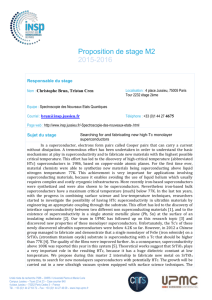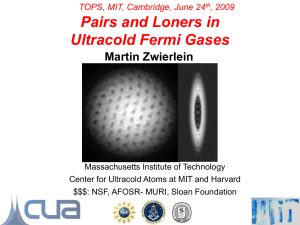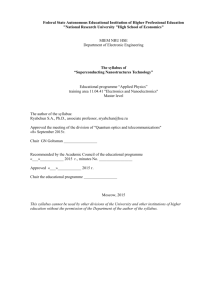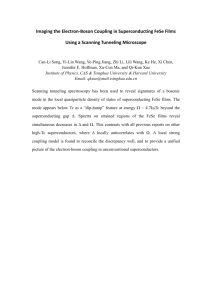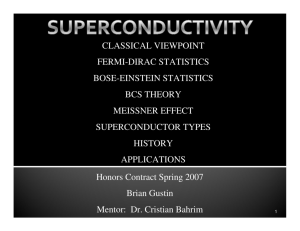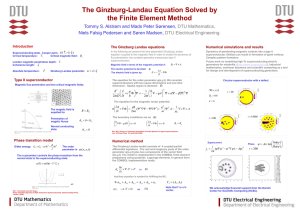Superconductivity and Superfluidity
advertisement
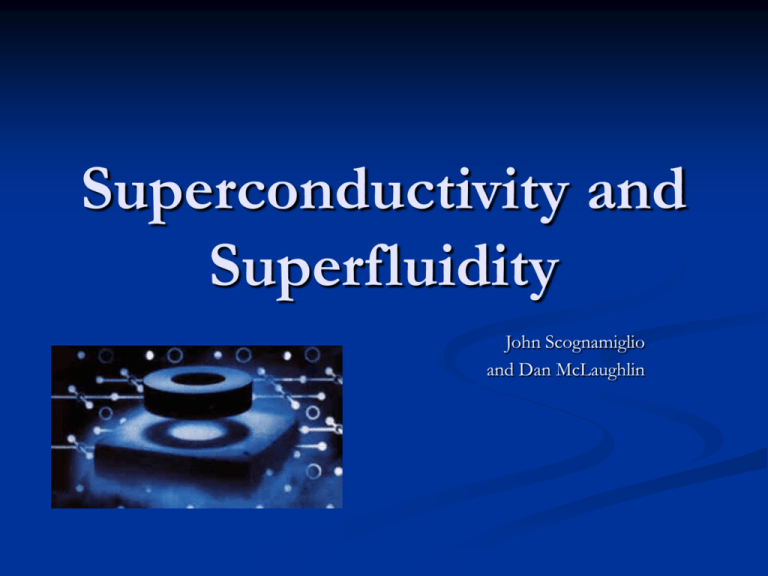
Superconductivity and Superfluidity John Scognamiglio and Dan McLaughlin Superconductivity What is superconductivity? Superconductivity is a phenomenon occurring in certain materials at low temperatures, characterized by exactly zero electrical resistance and the exclusion of the interior magnetic field. Superconductor is an a material that will conduct the electricity without resistance below what’s called a critical temperature. Once set in motion, the electrical current will flow forever in a closed loop of superconducting material, making what’s virtually a perpetual motion scenario. History of Superconductors In 1911 Heike Onnes of Leiden University cooled mercury to the temperature of liquid helium (4 degrees Kelvin). Once this happened, the resistance disappeared. History of Superconductors In 1933, Walter Meissner and Robert Oschenfeld discovered that a superconductor repels magnetic fields. This is the principle upon which the electric generator operates. But, in a superconductor the induced currents exactly mirror the field that would have otherwise penetrated the superconducting material causing the magnet to be repulsed. This is what’s called the Meissner Effect. Meissner Effect Above the Critical Transition Temperature (Tc), the magnetic field goes through Below the Tc, the magnetic field goes around it History of Superconductors In 1957, three American scientists, John Bardeen, Leon Cooper, and John Schrieffer wrote the BCS Theory. It explained superconductivity at low temperatures close to absolute zero for elements and simple alloys. It fails however as temperatures increase and materials get more complex. BCS suggests that electrons team up in cooper pairs. Cooper pairs are two electrons that appear to "team up" in accordance with theory despite the fact that they both have a negative charge and normally repel each other. (Named for Leon Cooper.) Below the superconducting transition temperature, paired electrons form a condensate which flows without resistance. However, since only a small fraction of the electrons are paired, the bulk does not qualify as being a "bose-einstein condensate". http://www.superconductors.org/terms.htm#cooper History of Superconductors In 1986, Alex Muller and Georg Bednorz created a ceramic-like material that acted as a superconductor at 30K. This was unprecedented since ceramic is an insulator, scientists wouldn’t have guessed it to be a superconductor. This led to an enormous amount of research in the field. In January 1987, a group from the University of Alabama substituted Yttrium of Lanthanum in the Muller and Bednorz experiment and achieved a Tc of 92K. This was a breakthrough in because it’s the first time a material has been able to superconduct at a temperature higher than liquid nitrogen. History of Superconductors The world record is held by a thallium-doped, mercuric cuprate comprised of Mercury, Thallium, Barium, Calcium, Copper, and Oxygen. The Tc of this is 138K. (Hg0.8Tl0.2)Ba2Ca2Cu3O8.33 Uses of Superconductors Magnetic Levitation is currently one of the best uses for super conductivity. A train for example could be made to float on super conducting magnets, virtually eliminating the friction. These are advantageous because they are smaller than standard magnets, and electromagnets tend to waste much of the electricity via heat. The downfall is that a strong magnetic field, such as the one needed in a case like this can create a biohazard. These trains are called the MagLev Trains. The first US MagLev is set to debut this year. The Yamanashi MLX01 MagLev train. Uses of Superconductors Biomagnetism is another field in which superconductors are being used in. by impinging a strong superconductor-derived magnetic field into the body, hydrogen atoms that exist in the body’s water and fat molecules are forced to accept energy from the magnetic field. They then release this energy at a frequency that can be displayed graphically by a computer. The Korean superconductivity group has carried biomagnetic technology a step further with the development of a double relaxation oscillation superconducting quantum interference device for use in magnetoencephalography. This device is capable of sensing a change in a magnetic field over a billion times weaker than the force that moves the needle on a compass. Thanks to this, the body can be probed to certain depths without the need for the strong magnetic field associated with MRI’s. Uses of Superconductors The Superconducting Super-Collider project was planned for construction in Ellis county, Texas before congress cancelled the project. The concept of such a large, high-energy collider would never have been viable without superconductors. High-energy particle research hinges on being able to accelerate sub-atomic particles to nearly the speed of light. Superconductor magnets make this possible. Uses of Superconductors Electric generators made with superconducting wire are far more efficient than conventional generators wound with copper wire. In fact, their efficiency is above 99% and their size about half that of conventional generators. These facts make them very lucrative ventures for power utilities. General Electric has estimated the potential worldwide market for superconducting generators in the next decade at around $20-30 billion dollars. Late in 2002 GE Power Systems received $12.3 million in funding from the U.S. Department of Energy to move hightemperature superconducting generator technology toward full commercialization. Types of Superconductors Type 1 Superconductors: comprised mainly of metals and metalloids that show some conductivity at room temperature. They require incredible cold to slow down enough to facilitate unimpeded electron flow in accordance with what is known as the BCS theory explained earlier. Categorized as the soft superconductors. They require he coldest temperatures to become superconductive, and the transition is VERY sharp Some examples are: Lead Tin Zinc Titanium Rhodium 7.196K 3.72K 0.85K 0.40K 0.000325 K Types of Superconductors Type 2 Superconductors comprised of metallic compounds and alloys. They achieve higher Tc’s than Type 1. There still lays a mystery behind the reason for this, however. The highest Tc attained at ambient pressure is 138K (Hg0.8Tl0.2)Ba2Ca2Cu3O8.33 Categorized as the hard superconductors. Their transition from a normal to superconducting state is gradual. Type 2 allow some penetration by an external magnetic field into its surface. Types of Superconductors Type 2 (Continued) “The first superconducting Type 2 compound, an alloy of lead and bismuth, was fabricated in 1930 by W. de Haas and J. Voogd. But, was not recognized as such until later, after the Meissner effect had been discovered. This new category of superconductors was identified by L.V. Shubnikov at the Kharkov Institute of Science and Technology in the Ukraine in 1936(1) when he found two distinct critical magnetic fields (known as Hc1 and Hc2) in PbTl2. The first of the oxide superconductors was created in 1973 by DuPont researcher Art Sleight when Ba(Pb,Bi)O3 was found to have a Tc of 13K.” http://www.superconductors.org/ Recent Events in Superconductivity 14 February 2006 Physicists in Japan have shown that "entirely end-bonded" multi-walled carbon nanotubes can superconduct at temperatures as high as 12 K, which is 30 times greater than for single-walled carbon nanotubes. The discovery has been made by a team led by Junji Haruyama of Aoyama Gakuin University in Kanagawa. The superconducting nanotubes could be used to study fundamental 1D quantum effects and also find practical applications in molecular quantum computing (Phys. Rev. Lett. 96 057001). Haruyama and colleagues have designed a system in which there is a superconducting phase that can compete with the TLL phase and even overcome it -- a feat hitherto believed impossible. Carbon Nanotube – rolled up sheets of graphite which have a diameter in the nanometer range. http://physicsweb.org/articles/news/10/2/8/1 Recent Events in Superconductivity China is attempting to build the first “artificial sun” Jan 21, 2006 A full superconducting experimental Tokamak fusion device, which aims to generate infinite, clean nuclearfusion-based energy, will be built in March or April in Hefei, capital city of east China`s Anhui Province. http://www.angolapress-angop.ao/noticiae.asp?ID=409853 What is Superfluidity? What is superfluidity? · Superfluidity is the phenomenon wherein a substance undergoes a state change that completely removes viscosity – the matter flows infinitely and without friction. The lack of friction is directly related to the infinite mobility of a superfluid – friction creates heat, and even slight heat (say from light) can cause a superfluid to return to a normal fluid state. The lack of friction allows the perpetual motion of the superfluid to exist and serves as a “loophole” in thermodynamics. “Lisa, in this house, we obey the laws of thermodynamics!” - Homer Simpson Superfluidity’s History · Pyotr Leonidovich Kapitsa, John F. Allen, and Don Misener first discovered superfluids in 1937 after 1908 research noted that, because of its small mass (4.002602, for those of you without your periodic table of elements) and weak forces between its atoms, helium does not enter from its liquid state to its solid state without high pressure (25 atm). The researchers fooled with slight modifications in temperature to see its effect on helium atoms and found a new phase of matter that they called “superfluid.” What is Superfluidity? · Whereas superconductivity deals with an environment wherein electrons can flow without resistance, superfluids are atoms that can flow without friction. · Superfluids operate at extremely low temperatures, just above the range of absolute zero. · This seems to contradict the common conception that lowering temperature can eventually slow atoms to a complete stasis and exhibits quantum mechanics on a macroscopic, fully observable scale. How does it work? · The most common matter used in superfluid studies is the helium isotope, helium-4. When helium-4 is cooled to 5.2º K, it turns into a liquid. Further cooling doesn’t immediately result in a state change into a solid. Instead, as long as pressure remains moderate, helium-4 becomes a superfluid at 2.17º K. Being a boson, it adheres to Dose-Einstein condensate dynamics in interacting systems. · Helium-3, the only other stable isotope of helium, also becomes a superfluid at a low enough temperature, 2.6 mK, and is about one millionth as abundant as helium-4. · Bosons are particles with an integer spin; fermions are particles with halfinteger spins. Only one fermion can occupy a given quantum state whereas there are no limitations for bosons. The lack of restrictions on bosons gives way to Bose-Einstein condensates. How does it work? · Bose-Einstein condensates are bosons cooled to temperatures just above absolute zero and are considered a phase of matter with odd characteristics, such as a lack of friction and the propensity to mold to the shape of their container and surround it rather than fill it, overcoming gravity in the process via quantum mechanics. Bosons, at a low enough temperature, occupy their lowest possible energy state, and various anomalies occur, superfluidity being one of them. How does it work? · “Because of the characteristic profile of the heat capacity curve, the temperature at which the transition takes place is called the lambda temperature (Tλ).” (quoted text and diagram from http://www.yutopian.com/Yuan/TFM.html) Why Superfluidity is Important · The most common (though “common” is used lightly here) practical application for superfluids lies in the use of helium-3 and helium-4 in cryogenics, most specifically dilution refrigerators. This is because of their usefulness via mobility at incredibly low temperatures. Also, their low temperature results in less thermal interference with the natural temperature of outer space and any machinery out there. · Superfluids can be used in gyroscopes without creating disruptive vibrations. · Another important aspect of superfluids is that they exhibit quantum mechanics on a large scale (measurable in centimeters) in terms of boson and fermion interactions. When placed in a rotating, sealed container, the speeds at which the superfluids rotate is in a state of quantized vorticity, or exact, increasing gradations of speed emanating from the center of the rotation. Strange Phenomenon · For a normal liquid, one can take a container of the liquid and make it flow outward by using a siphon (i.e. a hose or tube) whose end is below the source and has an initial force (suction) acting on it. This is because, in part, of gravity and pressure working in a roundabout manner. The liquid will at first go up out of the tube to reach the final destination below its starting point. With superfluids, no external force or mechanism is needed for the matter to flow upwards (coining the term the “fountain effect”) and out of a container. Experiments! We Are Science! · In 2000, hydrogen was revealed to be a superfluid, but only under specific circumstances, so exact and unstable that any substantial amount of a hydrogen superfluid is unattainable at this time. In the experiment, researchers reasoned that because of Bose-Einstein condensation, the expected temperature that hydrogen would be a superfluid occurs after the temperature that it becomes a solid. To counter that, hydrogen droplets were surrounded by larger helium-4 droplets (which would cool at 0.38 K), and some had helium-3 droplets enveloping the helium-4 (which would cool at 0.15 K). Experiment! Continued · To test whether it became a superfluid or not, the hydrogen atom enveloped a linear carbonyl sulphide molecule (OCS). Also, instead of using hydrogen, they used “parahydrogen,” which utilizes protons that spin in opposite directions. The droplets were placed in a vacuum that was measured by an infrared laser. If hydrogen did act as a superfluid, a substantial amount of it would break away from the OCS. The experiment showed some ambiguity as to exactly when hydrogen becomes a superfluid, but the researchers speculated that it was at 0.15 K after running a similar experiment with deuterium. More Experiments · On December 23rd, 2005, a study was published that showed physicists what they had been wondering for the better half of a century: superfluidity comes, in part, from the quantum interaction of equal fermion pairings, but what would happen if an unequal amount of fermions were in a system? Scientists at Houston’s Rice University took fermionic lithium-6 atoms, cooled them to 30 billionths of a degree over absolute zero, ad studied them to observe any quantum pairings, manipulating the spin of fermions via radio waves. They were able to create an excess of 10% unpaired fermions without having any deleterious effect on the superfluid. They successfully created a superfluid gas. Reflecting on the Lithium-6 Experiment · "The gas behaves as if it is still perfectly paired, which is quite remarkable given the excess of spin-up atoms. This was unexpected, and it could signal a new, exotic form of superfluidity that may be akin to the electron pairings in unconventional superconductors or to the quark soup that's predicted to exist at the heart of the densest neutron stars." – Randy Hulet, head of the experiment. Hypothetical Superfluids · Astrophysicists hypothesize that neutron stars (stars created as the result of certain types of supernovas and are characterized by an incredibly high mass density, a remarkably small size, and a large rotation speed) contain neutron and proton superfluids, but because of the difficulty in directly observing such phenomenon, this is speculation. References Superconductivity http://www.physnet.unihamburg.de/home/vms/reimer/htc/contents.html http://en.wikipedia.org/wiki/Superconductivity#Theories_of_supercond uctivity http://www.superconductors.org/INdex.htm http://physicsweb.org/articles/news/10/2/8/1 http://www.angolapress-angop.ao/noticia-e.asp?ID=409853 Superfluidity http://en.wikipedia.org/wiki/Superfluidity http://www.fluidmech.net/msc/super/super-f.htm http://physicsweb.org/articles/world/13/11/3 http://www.yutopian.com/Yuan/TFM.html http://www.sciencedaily.com/releases/2005/12/051223090405.htm http://irtek.arc.nasa.gov/DR_page/DRuses.html

